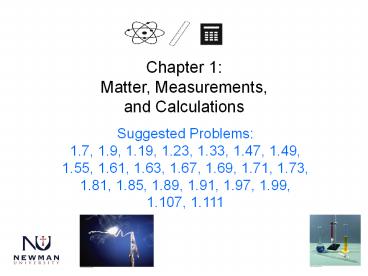Mathematics Used in Chemistry - PowerPoint PPT Presentation
1 / 32
Title:
Mathematics Used in Chemistry
Description:
Chapter 1: Matter, Measurements, ... A water molecule is composed of 2 hydrogens and one ... measurements were further standardized by adopting ... – PowerPoint PPT presentation
Number of Views:97
Avg rating:3.0/5.0
Title: Mathematics Used in Chemistry
1
Chapter 1Matter, Measurements, and Calculations
Suggested Problems 1.7, 1.9, 1.19, 1.23, 1.33,
1.47, 1.49, 1.55, 1.61, 1.63, 1.67, 1.69, 1.71,
1.73, 1.81, 1.85, 1.89, 1.91, 1.97, 1.99, 1.107,
1.111
2
Chemistry
- Chemistry Is the scientific study of matter and
the changes matter undergo - Chemistry is the foundation for many other
scientific disciplines
3
What is Matter?
- Definition Anything that has mass and occupies
space (________) - Examples of Matter
- Atoms Fe, C, Na, Pb
- Compounds NaCl, Fe2O3
- Molecules H2O, C12H22O11
- What about Air? Is it Matter? (________)
4
Properties of Matter
- Property scientific word used to describe an
objects characteristics - All properties are divided into two main
categories - Physical
- Chemical
5
Physical Properties
- Definition Properties that can be observed or
measured without changing the composition of the
matter - Examples
- Color, Size, Shape, Texture
- Boiling Point , Melting Point, Mass, Volume
- Density
6
Chemical Property
- Definition Properties exhibited by matter when
an attempt is made to change the matter into
another substance - Examples
- Flamability, Reactivity
7
Physical and Chemical Changes
- These are really another way of stating/thinking
about physical and chemical properties - Examples
- Breaking a baseball bat (_________)
- Baking Bread (________)
- Boiling Water (__________)
- Freezing Water (_________)
- Remember it is the composition of the matter that
is important not what it is called
8
Categorizing Matter
- There are four states of matter
- (___________)
- (___________)
- (___________)
- (___________)
- Plasma ionized gas (containing positive ions and
electrons)
9
States of Matter
- Solid
- Definite volume and shape
- Liquid
- Definite volume but not shape
- Takes the shape of its container
- Gas
- No definite volume or shape
- Will not only take the shape of its container it
will fill it completely
10
States of Matter
- Microscopic view of matter
- Solid Liquid Gas
11
Definitions
- Atoms
- Basic building block of matter
- Element
- Pure substance comprised of a single type of atom
Element Ga Melting Point 86 oF
12
Definitions
- Compound pure substances that are comprised of
more than one kind of atom in a fixed ratio by
mass - Example
- NaCl
- Always one sodium atom with one chlorine atom
13
Definitions
- Molecule groups of atoms chemically bonded
together into a discrete unit - H2O
- A glass of water contains many water molecules
- A water molecule is composed of 2 hydrogens and
one oxygen atom - Can an element be a molecule? (____)
14
Classifying Molecules
- H2, O2, F2, Br2, I2, N2, and Cl2,
- HOFBrINCl
- Diatomic Molecules
- Made of two atoms
- Homoatomic
- Contains only one type of atom
- CO2, H2O, H2S
- Triatomic
- Made of three atoms
- Heteroatomic
- Contain two or more types of atoms
15
Classifying Molecules
- S8, C6H12O6
- Polyatomic Molecules
- Made of more than three atoms
- Can be heteroatomic or homoatomic
16
(No Transcript)
17
Measurement Units
- Qualitative properties can be assesed without
measurement - Example
- An apple is red
- Sandpaper is rough
- Some properties require measurement
- These are called (___________) properties
18
Measurement
- True or False?
- The predicted high temperature for today is 35.5
- A measurement requires both a numerical value and
proper (_________)
19
Units
- Earliest Units were based on the dimensions of
the human body - The cubit
- Length along the forearm to the tip of the middle
finger - Problem
- Not all humans are the same size
- Scientist need a standard system of measurements
20
Units of Measurement
- Around the time of the French Revolution a
standard system of units was developed in France - This system is called the (______) system
- The metric system has been adopted and used by
most nations in the world including the U.S. - In 1960 scientific measurements were further
standardized by adopting certain units for
specific measurements - These units are known as the SI units
21
SI Units of Measurement
Base quantity Name Symbol
length meter m
mass kilogram kg
time second s
electric current ampere A
thermodynamic temperature kelvin K
amount of substance mole mol
luminous intensity candela cd
22
Common Metric System Prefixes
23
Practice Problem
24
Commonly Measured Values Volume
- Basic Shapes
- Cube
- Rectangle
- Sphere
- Cylinder
L x L x L
L x W x H
4/3(?r3)
?r2h
25
Volume
- Measuring Volume
- Used when object has an irregular shape
26
Commonly Measured ValuesMass vs. Weight
- Mass is the amount of matter an object has
- This is the value you get by putting objects on a
balance - Weight is a measurement of the force exerted on
an object by gravity - W mass x gravity
27
Practice Problem
- An cylindrical object with a radius of 4.02 cm
and a height of 6 cm has a mass of 2.2 lbs. What
is the density of this object in g/cm3? (Hint 1
pound equals 454 grams)
28
Commonly Measured ValuesTemperature
- Common Formulas Needed for temperature
conversions
29
Common Temperatures
30
Practice Problem
- I measured the temperature in the lab yesterday
to be 13C. What is this temperature in
Fahrenheit?
31
Significant Figures and Scientific Notation
- All nonzero digits are significant
- Zeros between significant figures are significant
- Other zeros are significant if they are both
- To the right of a significant figure
- To the right of a decimal point
32
(No Transcript)































